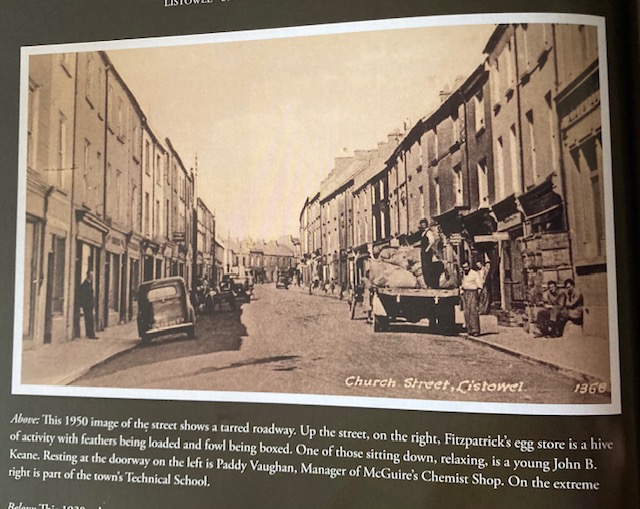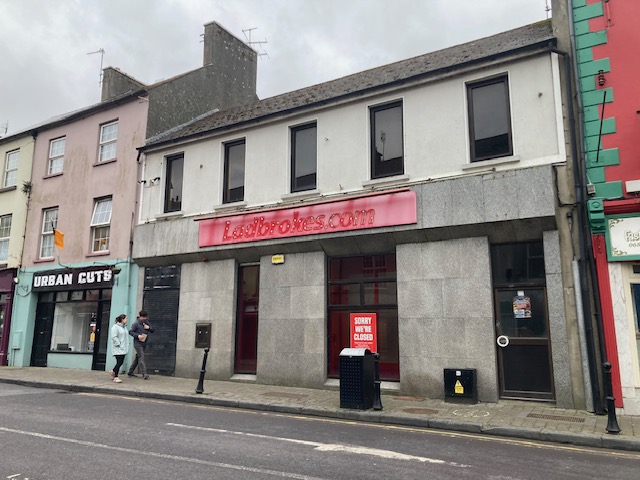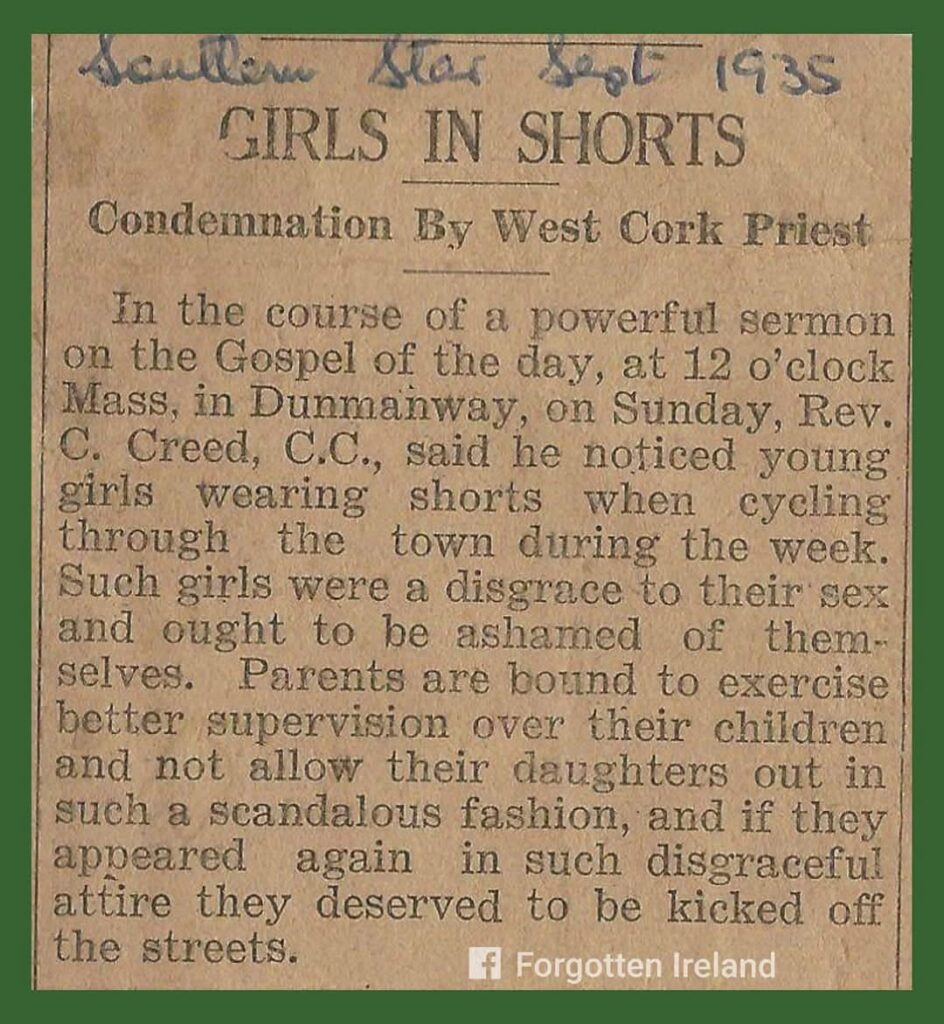
Church Street
<<<<<<<<
Fitzpatrick’s

Liz McAuliffe recognised her late father as another of the men at Fitzpatrick’s door in this photo from Vincent Carmody’s Listowel, Snapshots of an Irish Market Town.
Interview with Derry Fitzpatrick on Feb 10 2025
Fitzpatrick’s Hatcheries of Kanturk was a huge part of commercial life in Listowel until its closure in 1972.
I talked to Derry Fitzpatrick who kindly told me much of the story.
Listowel was an outpost of the Kanturk hatchery operation. Listowel Fitzpatrick’s was run mainly by three men, Jerome Barry from Banteer, Johnny Riordan of Kanturk and Kevin Sheehy, Listowel. Johnny lived over the store in Church Street.
Kevin went on to have his own successful poultry business later on.
A few Facts:
Fitzpatrick’s was the biggest exporter of feathers during WW2.
Fitzpatrick’s had 5 trucks on the road, 3 in Kanturk and 2 in Listowel.
At Christmastime, Fitzpatrick’s exported 2,000 free range turkeys to England.
A truck load of turkeys or sometimes 2 went daily to the boat.
300 extra jobs were created in the run up to Christmas. These people were employed full time plucking turkeys.
The turkeys were sometimes sent to O’Sullivan’s refrigerated storage in Cork. This was located where the Mercy hospital is now.
Fitzpatrick’s traded in eggs, chickens, geese, turkeys, guinea fowl, feathers, skins and at one stage, scrap metal as well.
In Kanturk they had 2 hatcheries and a workforce of 100.
3 or 4 men were fulltime employed grading eggs for size. 6 men were full time skinning rabbits.
According to Derry, farms of land were bought from the profits of the rabbit industry.
Rabbits were a huge part of the Listowel operation. They could be trapped easily and in huge numbers and they were free. In the 1940s and 50s the rabbit population in Ireland was in the millions and these rabbits were a scourge to farmers, eating and damaging crops. They welcomed the rabbit trappers on to their land. A comfortable living could be made selling rabbits to Fitzpatrick’s. Rabbit was once regularly on the menu in Irish homes. Derry remembers eating rabbit several times a week.
In 1954 that all changed. A disease called mixametosis was introduced from the UK in an effiort to cull the rabbit numbers. Even though the disease was harmless to humans, the thoughts of eating the meat of a diseased animal or the horror at the sight of the suffering the disease brought to the rabbits put people off eating rabbit. It had been a staple in the Irish and British diet up to then. It was the beginning of the end of the rabbit trade.
Eggs, which were supplied by farms specialising in poultry, continued to be a huge part of Fitzpatrick’s hatchery operation. Fresh eggs were sold to the shops and liquid eggs to the catering industry.
Finbarr McAulliffe ran a smaller poultry business in Listowel. He and Fitzpatricks were friends and there was no rivalry or animosity between them. The second string to Finbarr’s bow was fish, which was a commodity Fitzpatrick’s, coming from one of the most inland towns in Ireland, didnt dabble in.

The building is unoccupied today.
If anyone reading this has any more to add to this story I’d love to hear from you. Maybe you were one of the rabbit trappers. Did you pluck a few turkeys with John B. Keane? Did you love to hang out on the doorstep with Johnny Riordan? We’d love to hear your stories.
<<<<<<<<
If they could see our girls now….

<<<<<<<<
from the Archives
The Columbia Cauldron 1930
We reproduce it here that our readers may know that in many parts of the
world including America, there is a growing revolt against the institution of unearned income and the consequent waste and extravagance in modes of living.. Some day a young Earl or Marquis or maybe a rubber king or oil magnate will tell us the full tale of the boredom
“Viscount Ennismore, the 22-year-old son of the Earl of Listowel, is
an earnest young Socialist who is seeking to apply his idealism to his
personal life.
Recently he decided to give up his title and asked his friends to call
him Mr. W. F. Hare. Now he has decided to surrender unearned income
and renounce his fortune. He proposes to live on $20.00 a week whilst
studying in London for a philosophy degree. Apparently he has
discovered others who have his views, for he has founded a friendly
society, to be known as Neighbours, Ltd., to enable wealthy people to
The weekly incomes of the members will devote their fortunes to social
purposes, be limited to $20.00 for single men or women, $30.00 for
married men and $2.00 for each dependent child. The problem which Mr.
Hare is facing is a very real one for many rich Socialists, and we
shall watch his experiment with interest. May we suggest to him and
his friends that the best expenditures of unearned incomes which they
feel Capitalism has wrongfully provided would be to devote it to
Socialistic propaganda and organization?”
<<<<<<<<
Wisdom from the internet

<<<<<<<
A Fact
In 1807 London’s Pall Mall was the first street to be lit by gaslight.
<<<<<<<

Nicholas
I can well believe the clerical vitriol against the ‘girls in shorts’ article above! The ‘kicking them’ suggestion is akin to a hysterical loss of Christian virtue, and suggests serious hatred of females, whatever about their shorts. Thank the Lord that such unholy attitudes are no longer part of a true religion.
Now, a lighter side to a 1950-60’s’s clerical botheration with a woman’s lower-deck duds!
Our P.P. in a Co. Meath village was very pernickety about women’s dress in church. The Mantilla was
de jure and for some reason,the men and women were corralled in separated aisles. The purpose of the Mantilla was to veil a woman’s physical beauty, so that the beauty of God may be glorified instead. Our Lady had her own place.
A woman from England had married a local man and they had their home in the Parish. She was a fine Christian woman who dressed very up- to- fashion. She came to Mass one Sunday wearing slacks. This was a minor heresy of which she had no knowledge. The P.P. was not a happy man, so the young Curate was dispatched the following morning to the woman’s home, a mile or two from my home. The Curate was most embarrassed at his duty to put the woman’s nether garments to right, and was pleased that he met her husband in the farmyard. He explained that the P.P. was not pleased that his wife had worn slacks to mass and that they were not allowed.
The husband was a noted ‘gas-man’ who was a legend in his time, having gone to fight for General Franco in the Spanish Civil War, as was reputed.
He reassured the Curate that he would make sure that things would be put right, and told the Curate to tell the P.P. not to worry about the slacks as he would personally see to it that they would not fit his wife for very much longer!
The Curate delivered the message with some trepidation, sensing that the P.P. would lose this round!
That woman was devoted to Mass and the Sacraments and spent her life in our Parish as leader and the back-bone of the Parish and, to her end was the leading light in every aspect of Church activity,welfare and upkeep. May she rest in peace.
Kathleen Csoka
The all I need to know is hilarious
John Keane
Mary, another gem. Thank you. My father worked for Fitzpatrick’s.
listowelconnection
He did indeed, John. Derry mentioned him among the pluckers. Johnny Riordan from Kanturk who ran the operation was a first cousin of my mother’s. Lots of connections!
Muireann O Sullivan
Hello Mary. I think the now unoccupied building in your photo was the former ‘Old Tech’. It was purchased after by Michael Barrett RIP who had flats there and, if I remember correctly, Liam Lawlee operated a veg shop from there. The barber’s, to the left of same, was Fitzpatrick’s.